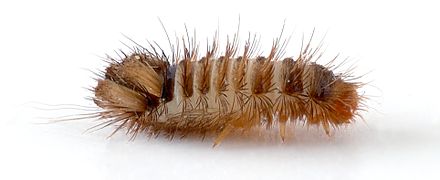Springing into Pest Season (AKA: What's bugging you now?)
- Chelle Hartzer

- Apr 6, 2021
- 3 min read
Many of our pest species have seasonal trends. Even if you live in southern climates without much of a temperature shift during the year, there are still wet and dry seasons that will affect insect pests. Around this time of year in the U.S., I start seeing lots of folks finding and asking about carpet beetles. Specifically the varied carpet beetle, Anthrenus verbasci. Here are some interesting facts on this cool little beetle.
This is one of my favorite Dermestid beetles because it is quite pretty. Look closely at the body and you see it is covered in small scales. Those scales are brightly colored with white and yellow, some brown and black. Unlike most beetle larvae, the larvae of the varied carpet beetle are very distinctive with the hairs and the pattern of the hairs on the body.
So why spring? Carpet beetles are considered a stored product pest because they can be found inside eating on all manner of protein sources. They can feed on human foods like nuts and seeds, animal foods like pet food and birdseed, and other animal based products like wools, feathers, and taxidermy. However, there is a healthy outdoor population too, feeding on those seeds, nuts, feathers, and carrion. Those outdoor beetles overwinter as adults, so in the spring, they emerge from their winter hibernation and start looking for food and friends. They can enter structures through almost any opening, and since it is spring, folks have windows and doors opened.
Adults are short lived, just a few weeks, and like to feed on pollen. With all the new flowers in spring, they have plenty to feast on as they look for good items to lay their eggs on. The larvae are the long-lived and damaging stage. The carpet beetle got that common name because these were often found feeding on carpets, back in the days when carpets were made almost exclusively from animal products like wools, furs, and skins. Today, most of our floor coverings are synthetic. There are plenty of other items inside structures that can provide a food source.
Museums are particularly susceptible to these beetles. A recent paper was published on a similar species (A. flavipes) and the damage it did to multiple specimens. They estimated the infestation had been going on for years. They had done periodic visual inspections but did not have a monitoring program in place. This shows the importance of a monitoring program that could have caught this issue early, before significant damage had occurred.
What makes varied carpet beetles (and other Dermestids) particularly tricky is there are many items that we don’t necessarily think of as being animal based. Finding the material they are feeding on and infesting is often tricky. For example:
Damage to the key pads (composed of felt enclosed in fish buoyancy bladder skin) of a clarinet
Old upholstered furniture – often stuffed with horsehair, wool, or other animal products
Infestations are often unknown for months or even years. These beetles take between one to two years to develop from egg to adult. Since adults only lay about 40 eggs, those few larvae can be hiding within the infested object, slowing, inevitably damaging it. Then the adults emerge, lay more eggs, and the unchecked population has the potential for exponential growth over a few years. By the time damage is evident in a visual inspection, it is likely extensive.
These beetles have worldwide distribution and can be found nearly anywhere there is a food source. Comment below with the strangest thing you have found these infesting! If you have any type of materials that could be susceptible to varied carpet beetles (or other Dermestidae species), having a good monitoring program is essential. Contact us to find out how we can help you develop and execute those programs.
Lagniappe - apparently these beetles also go by the common name of bow bugs and museum beetles as well as variegated carpet beetle, varied cabinet beetle, and small cabinet beetle.















Comments